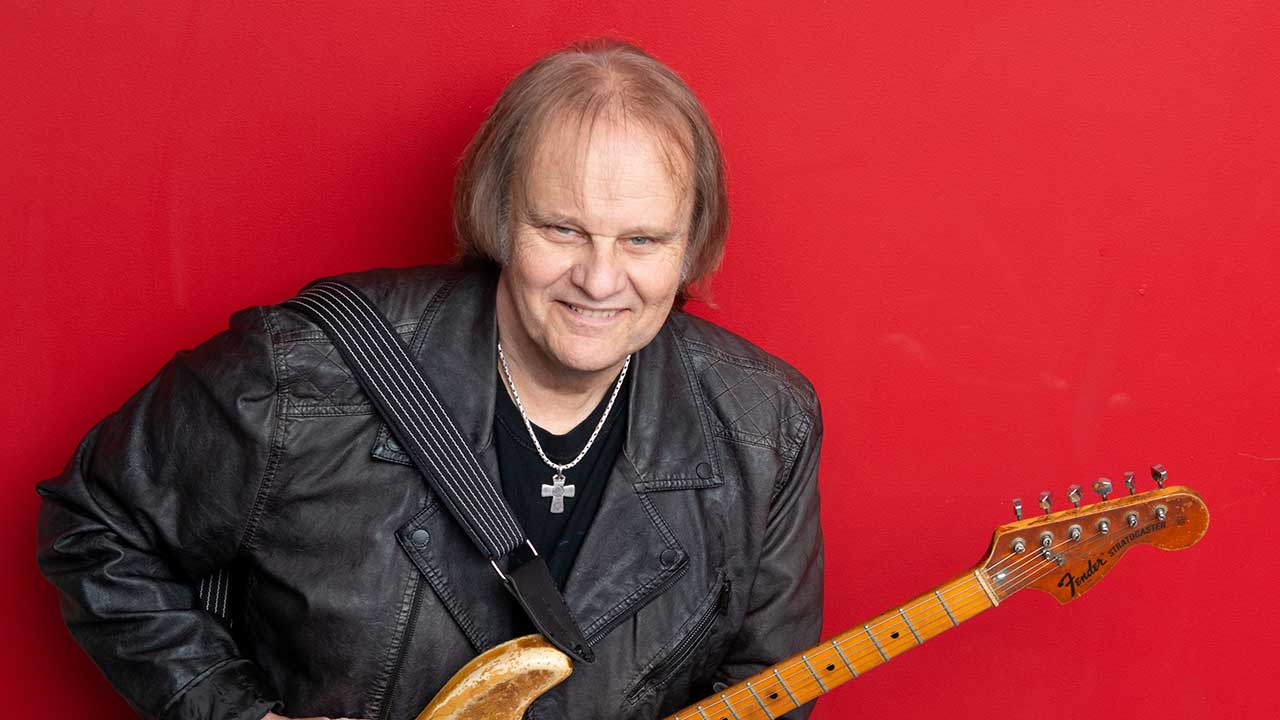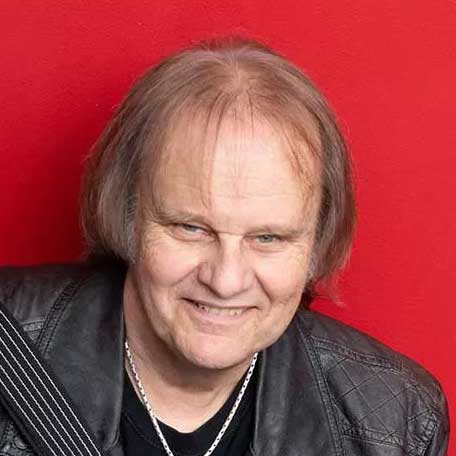Walter Trout: the 10 records that changed my life
As blues legend Walter Trout gears up for the release of his Ordinary Madness album, he reveals he albums that got him started

The albums that changed my life were all released when I was young. I haven’t gone out in the last 30 years and purchased an album that has changed my life, so these albums are all from my formative years, when albums truly did change my life and send me in certain directions.
They all helped me hone in and focus on the direction I was going to take with my life. They all pointed me in a certain direction. They all added to my understanding of what it was I wanted to do with my life, how I wanted to do it, and how I wanted to approach it.
Every one of those albums is epic. In my life, those albums are epic. Since I’ve been an adult and since I’ve been a professional musician, I have to say I’ve gone out and bought albums that I love dearly and listen to all the time, but they didn’t affect the direction of my life like these records did.
These had a profound impact on the trajectory of my life, and without these albums I might not have ended up doing what I’m doing.
Walter Trout's new album Ordinary Madness is out this week.

Duke Ellington - Ellington at Newport
It’s a live album, and it’s Duke Ellington at the Newport Jazz Festival. At the time, when I was a little kid, I was an aspiring Jazz trumpet player. One of the reasons that this changed my life was because I was a big fan of a song called Diminuendo and Crescendo in Blue, and on that song a saxophone player named Paul Gonsalves played 27 choruses and started a riot! They literally rioted, and they had to stop the band and the whole thing. And it’s all on that record!
When I was 10 years old my mother and I were going to go see Duke Ellington at a theatre. We went there in the afternoon to buy tickets, and some cars pulled up and some very well dressed men got out carrying horn cases and my mother said, “look! It’s Duke and his orchestra.” We walked around the back and there was Paul Gonsalves, the guy who had played the solos.
Sign up below to get the latest from Classic Rock, plus exclusive special offers, direct to your inbox!
I was a 10 year old kid, and I walked up and said, “Mr Gonsalves? I loved the solo you played on Diminuendo and Crescendo In Blue! And we was like, “wow!”. We ended up being escorted into the dressing room, and I got to spend the day with Duke Ellington and his orchestra. I got to hang out with them and talk to them about music, and the great trumpet player Cat Anderson gave me a trumpet lesson. So that album, meeting Duke Ellington and his charisma, his humour, his work and his kindness really made me want to be a musician. That changed my life, that meeting.
Bob Dylan - The Freewheelin’ Bob Dylan
I had been listening to Jazz and wanting to play Jazz, and then my brother brought this album home and something about it grabbed me. It was the simplicity of the songs but the emotional intensity. And I decided that I wanted to learn how to play the guitar and play this folk music. I had become aware of acoustic guitar music. That album made me want to get a guitar, and I started spending more time on the guitar than the trumpet.
The Beatles - Meet the Beatles
I was 13 and I saw The Beatles on television. I saw them on the Ed Sullivan show. 78 million people watched that show, which was almost half of the United States. I went into school the next day and nothing was the same. The world changed. I decided that I had to get an electric guitar and try to start playing music with other people.
I was becoming pretty good on the guitar by 13. I had the chords and barre chords down and I could play all of these Bob Dylan tunes. But then it was time to learn Beatles songs. So I went out and got an Electric guitar!
The Paul Butterfield Blues Band - The Paul Butterfield Blues Band
Once again this was my older brother. He brought this album home and said, "I knew you’re learning guitar, and I’m gonna play this record and you better sit down, because when you hear this guy play the guitar you’re gonna fall down."
And on the back of that first Butterfield album it said, “To fully appreciate the sound of The Paul Butterfield Blues Band, play this record loud.” Now this was 1965, so we put it on and we cranked it up and in came the guitar player Michael Bloomfield and I listened to that album about five times in a row and I went to my mother and I said, “I know what I wanna do. I want to play guitar like that guy.”
So now it was no longer the folk music, it was no longer the Beatles or The Monkeys, it was really nasty, raw blues stuff that attracted me after that album. So that’s when I decided that I had to get the same guitar that Mike Bloomfield was playing. On the back of that album, he was playing a telecaster. So I went and got an after school job and I started saving up my money. I worked in a department store after school to save my money to get a telecaster, a real guitar.
Al Cooper, Mike Bloomfield, Steven Stills - Super Session
About a year later I was saving my money, and the Telecaster at the time was going to be about $150. But on the front of this album, Mike Bloomfield was playing a Les Paul. So now because of this album, instead of a Telecaster I had to get a Les Paul because my hero was playing a Les Paul.
That guitar was $50 more, so I had to work even harder and longer, but I went out in 1968 and got myself a gold top Les Paul with money that I had saved working after school. And that was because of that album!
John Mayall and the Blues Breakers with Eric Clapton - the 'Beano' Album
I heard a different type of guitar playing here than was Bloomfield was doing. There was even a little more rock in the guitar, the tone of the guitar that Eric Clapton had in his approach.
When I listen to recordings of me in my early years, I sound like I’m imitating Michael Bloomfield. But then I heard Eric Clapton. That really changed my approach also. I got more into realising that you could blend rock'n'roll and blues. You could blend the two and come up with this hybrid guitar approach and that album really did that for me.
I was very honoured in 2013 to go to the Classic Rock Awards at the Roundhouse in London and present John Mayall with the lifetime achievement award for Classic Album for the 'Beano' album. I was up there on the podium and I was going to give John this award. I had flown there from LA with my wife and I was really, really sick. It was right before I was hospitalised. But I looked in the audience and there was Chris Barber. He’s the guy who originally brought Muddy Waters, Howling Wolf and Sonny Boy Williamson to England in the late 50’s. He was very old, he was in his 80s and I invited him up to the podium to help me give John the award and it was an amazing evening.
Later that night I was standing in a group of people at the after-party in the press room at the Roundhouse, and somebody tapped me on the shoulder. I turned around and it was Jimmy Page! His direct quote, I’ve never forgotten it, was, “Walter Trout, I’ve heard your work and I think it’s wonderful!”
So I said, “Jimmy Page, I’ve heard your work and I think it’s wonderful!” He started laughing hysterically and they dragged him away. That was a really cool moment for me.
Ray Charles – The Genius Sings The Blues
Now all along from the time I was a little kid, there was two albums that were always there for me and one was Ray Charles, called The Genius Sings The Blues. It’s an album that he did in his Atlantic years before he had big hits. It’s one of the most incredible blues albums you’ve ever heard. It showed me what the human voice could do and what an incredible vocalist could do with his music.
One of my memories is walking into a room when I was seven or eight years old and my mother was crying. That record was playing and I asked, “Mum what’s wrong?” and she said, “oh it’s that song, that song is making me weep.” That album has a special place for me and I still listen to it a lot.
Ella Fitzgerald - Ella sings Gershwin
It’s Ella Fitzgerald singing the songs of George Gershwin with just a piano player. She has a piano player named Ellis Larkins. It some of the most beautiful vocal music you will ever hear. She’s the greatest Jazz singer in the history of the world, Ella Fitzgerald. Those two albums have been there since I was a kid and they remain albums that I still listen to. They’re timeless.
BB King – Live At The Regal
It came out when I was still young and still trying to get going in music. It’s the ultimate recording of a master blues man commanding an audience and taking this audience on this journey with him and also involving the audience in what he’s doing.
It’s in the top three greatest live album ever done, and it could be his finest album. It’s a classic album among blues people. That album is the ultimate record of a master bluesman taking his audience on a rollercoaster ride and it’s there for you to hear.
James Brown – Live At The Apollo
This one affected me so greatly. It was recorded – I know it off the top of my head – on October 24 1962 at the Apollo in Harlem. It’s another example of hearing a master communicating and involving his audience and he has the audience in the palm of his hand and his band are so tight!
This album is another one that when it came in 1963 my brother brought it home. I was 12 years old and it got played incessantly. I was fascinated with the communication James Brown and the audience. It’s just an amazing thing!
I guess what’s always appealed to me with live albums is hearing great artists play to a room full of people. Not just their playing, but their talking between tunes. Taking their audience on a journey, and their audience going there very willingly... and loving every minute of it.
Walter Trout was a jobbing lead guitarist for the likes of John Lee Hooker and Big Mama Thornton before joining Canned Heat in the early 1980s and John Mayall’s Bluesbreakers in 1985. In 1989 he embarked on a solo career. He's released eight albums with the Walter Trout Band, five albums with Walter Trout and the Radicals, and 12 under the name Walter Trout.

